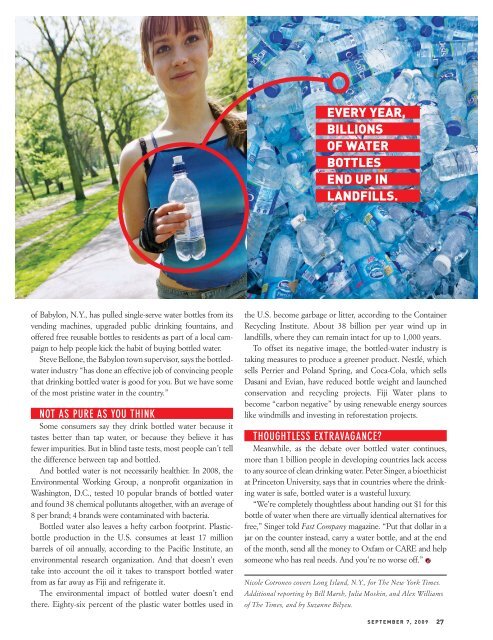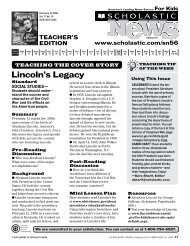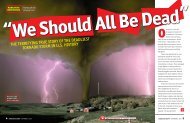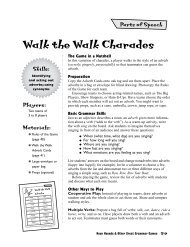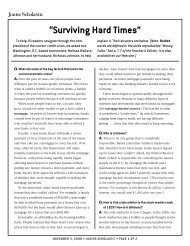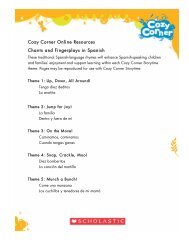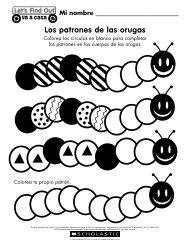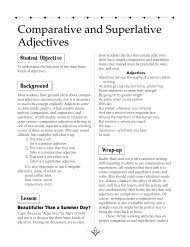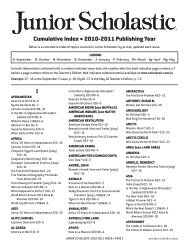3billion - Scholastic
3billion - Scholastic
3billion - Scholastic
You also want an ePaper? Increase the reach of your titles
YUMPU automatically turns print PDFs into web optimized ePapers that Google loves.
of Babylon, N.Y., has pulled single-serve water bottles from its<br />
vending machines, upgraded public drinking fountains, and<br />
offered free reusable bottles to residents as part of a local campaign<br />
to help people kick the habit of buying bottled water.<br />
Steve Bellone, the Babylon town supervisor, says the bottled-<br />
water industry “has done an effective job of convincing people<br />
that drinking bottled water is good for you. But we have some<br />
of the most pristine water in the country.”<br />
not as pure as you think<br />
Some consumers say they drink bottled water because it<br />
tastes better than tap water, or because they believe it has<br />
fewer impurities. But in blind taste tests, most people can’t tell<br />
the difference between tap and bottled.<br />
And bottled water is not necessarily healthier. In 2008, the<br />
Environmental Working Group, a nonprofit organization in<br />
Washington, D.C., tested 10 popular brands of bottled water<br />
and found 38 chemical pollutants altogether, with an average of<br />
8 per brand; 4 brands were contaminated with bacteria.<br />
Bottled water also leaves a hefty carbon footprint. Plasticbottle<br />
production in the U.S. consumes at least 17 million<br />
barrels of oil annually, according to the Pacific Institute, an<br />
environmental research organization. And that doesn’t even<br />
take into account the oil it takes to transport bottled water<br />
from as far away as Fiji and refrigerate it.<br />
The environmental impact of bottled water doesn’t end<br />
there. Eighty-six percent of the plastic water bottles used in<br />
every yeAr,<br />
billions<br />
of wAter<br />
bottles<br />
end up in<br />
lAndfills.<br />
the U.S. become garbage or litter, according to the Container<br />
Recycling Institute. About 38 billion per year wind up in<br />
landfills, where they can remain intact for up to 1,000 years.<br />
To offset its negative image, the bottled-water industry is<br />
taking measures to produce a greener product. Nestlé, which<br />
sells Perrier and Poland Spring, and Coca-Cola, which sells<br />
Dasani and Evian, have reduced bottle weight and launched<br />
conservation and recycling projects. Fiji Water plans to<br />
become “carbon negative” by using renewable energy sources<br />
like windmills and investing in reforestation projects.<br />
thoughtless extravagance?<br />
Meanwhile, as the debate over bottled water continues,<br />
more than 1 billion people in developing countries lack access<br />
to any source of clean drinking water. Peter Singer, a bioethicist<br />
at Princeton University, says that in countries where the drinking<br />
water is safe, bottled water is a wasteful luxury.<br />
“We’re completely thoughtless about handing out $1 for this<br />
bottle of water when there are virtually identical alternatives for<br />
free,” Singer told Fast Company magazine. “Put that dollar in a<br />
jar on the counter instead, carry a water bottle, and at the end<br />
of the month, send all the money to Oxfam or CARE and help<br />
someone who has real needs. And you’re no worse off.”<br />
Nicole Cotroneo covers Long Island, N.Y., for The New York Times.<br />
Additional reporting by Bill Marsh, Julia Moskin, and Alex Williams<br />
of The Times, and by Suzanne Bilyeu.<br />
September 7, 2009 27


